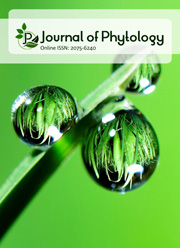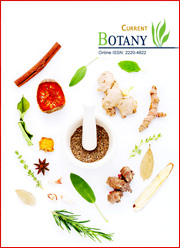Chemoprofiling of Cucumis pubescens Willd. fruits
DOI:
https://doi.org/10.25081/jp.2024.v16.8938Keywords:
Cucumis pubescens, HPLC, Spectral analysis, GC-MS, Bioactive compoundsAbstract
Cucumis pubescens, a notable therapeutic plant belonging to the Cucurbitaceae family is extensively utilized in South India’s habitual medicine. Despite its medicinal importance, the phytochemical content of this plant remains largely unexplored. The objective of the present study was to examine the phytochemical composition of the fruits of C. pubescens. Initially, HPLC analysis was employed to separate secondary metabolites, revealing seven major phytochemical fractions. The use of a suitable mobile phase system (Acetic acid: Acetonitrile: Water, 4:2:10) at 280 nm facilitated clear isolation. Subsequent spectral analyses confirmed the presence of bioactive compounds. UV-Vis spectral analysis indicated the abundance of flavonoids and tannins. The presence of functional groups, for instance, C=O (carbonyl), C-C (benzene), and Ar-C-H (aromatic hydrocarbon) were validated through FTIR. Further analysis through GC-MS identified 23 bioactive compounds, with quercetin and kaempferol being the predominant ones, followed by gallic acid and caffeic acid. The pharmacological activity of these compounds underscores the therapeutic potential of C. pubescens. In conclusion, this study highlights the rich chemical diversity of C. pubescens, suggesting its potential as a valuable medicinal species with pharmaceutical significance.
Downloads
References
Adebayo-Gege, G., Alicha, V., Omayone, T. O., Nzekwe, S. C., Irozuoke, C. A., Ojo, O. A., & Ajayi, A. F. (2022). Anti-atherogenic and cardio-protective properties of sweet melon (Cucumis melo. L. Inodorus) seed extract on high fat diet induced obesity in male wistar rats. BMC Complementary Medicine and Therapies, 22, 334. https://doi.org/10.1186/s12906-022-03793-w
Alam, M., Ahmed, S., Elasbali, A. M., Adnan, M., Alam, S., Hassan, M. I., & Pasupuleti, V. R. (2022). Therapeutic implications of caffeic acid in cancer and neurological diseases. Frontiers in Oncology, 12, 860508. https://doi.org/10.3389/fonc.2022.860508
Ani, O. N., Achikanu, C. E., & Asogwa, K. K. (2022). Evaluation of bioactive compound content, in-vitro antioxidant and anti-inflammatory effects of ethanol extract of the seed of Cucumis metuliferus fruit. GSC Biological and Pharmaceutical Sciences, 18(3), 113-125. https://doi.org/10.30574/gscbps.2022.18.3.0098
Araya, E. M., Adamu, B. A., Periasamy, G., Sintayehu, B., & Hiben, M. G. (2019). In vivo hepatoprotective and in vitro radical scavenging activities of Cucumis ficifolius A. rich root extract. Journal of Ethnopharmacology, 242, 112031. https://doi.org/10.1016/j.jep.2019.112031
Bationo, R. K., Dabiré, C. M., Hema, A., Nébié, R. H. C., Palé, E., & Nacro, M. (2022). HPTLC/HPLC-mass spectrometry identification and NMR characterization of major flavonoids of wild lemongrass (Cymbopogon giganteus) collected in Burkina Faso. Heliyon, 8(8), E10103. https://doi.org/10.1016/j.heliyon.2022.e10103
Bisognin, D. A. (2002). Origin and evolution of cultivated cucurbits. Ciência Rural, 32(4), 715-723. https://doi.org/10.1590/S0103-84782002000400028
Chen, L., Huang, G., & Hu, J. (2018). Preparation, deproteinization, characterisation, and antioxidant activity of polysaccharide from cucumber (Cucumis saticus L.). International Journal of Biological Macromolecules, 108, 408-411. https://doi.org/10.1016/j.ijbiomac.2017.12.034
Demsie, D. G., Yimer, E. M., Berhe, A. H., Altaye, B. M., & Berhe, D. F. (2019). Anti-nociceptive and anti-inflammatory activities of crude root extract and solvent fractions of Cucumis ficifolius in mice model. Journal of Pain Research, 12, 1399-1409. https://doi.org/10.2147/JPR.S193029
dos Santos, J. S., Cirino, J. P. G., de Oliveira Carvalho, P., & Ortega, M. M. (2021). The pharmacological action of kaempferol in central nervous system diseases: a review. Frontiers in Pharmacology, 11, 565700. https://doi.org/10.3389/fphar.2020.565700
Ezzat, S. M., Raslan, M., Salama, M. M., Menze, E. T., & El Hawary, S. S. (2019). In vivo anti-inflammatory activity and UPLC-MS/MS profiling of the peels and pulps of Cucumis melo var. cantalupensis and Cucumis melo var. reticulatus. Journal of Ethnopharmacology, 237, 245-254. https://doi.org/10.1016/j.jep.2019.03.015
Fathima, M. S. A., & Johnson, M. (2018). Spectroscopic studies on Pouzolzia wightii Benn. International Journal of Pharmacy and Pharmaceutical Sciences, 10(3), 124-132. https://doi.org/10.22159/ijpps.2018v10i3.19336
Gamble, J. S. (1935). Flora of the Presidency of Madras (Issued in II parts: 1-7 by Gamble, 8-11 by C.E.C. Fischer) (Vols. 1-3). Calcutta, India: Botanical Survey of India.
Griffiths, P. R., & de Haseth, J. A. (1986). Fourier Transform Infrared Spectrometry. (2nd ed.). New York: US: John Wiley and Sons, Inc.
Hendry, S. H. C., Schwark, H. D., Jones, E. G., & Yan, J. (1987). Numbers and proportions of GABA-immunoreactive neurons in different areas of monkey cerebral cortex. The Journal of Neuroscience, 7(5), 1503-1519. https://doi.org/10.1523/JNEUROSCI.07-05-01503.1987
Héthelyi, E., Tétényi, P., Dabi, E., & Dános, B. (1987). The role of mass spectrometry in medicinal plant research. Biomedical & Environmental Mass Spectrometry, 14(11), 627-632. https://doi.org/10.1002/bms.1200141110
Huang, R., Zhang, Y., Shen, S., Zhi, Z., Cheng, H., Chen, S., & Ye, X. (2020). Antioxidant and pancreatic lipase inhibitory effects of flavonoids from different citrus peel extracts: An in vitro study. Food Chemistry, 326, 126785. https://doi.org/10.1016/j.foodchem.2020.126785
Jeffrey, C. (1990). An outline classification of the Cucurbitaceae. In D. M. Bates, R. W. Robinson & C. Jeffrey (Eds.), Biology and Utilization of the Cucurbitaceae (pp. 449-463) Ithaca, US: Cornell University Press. http://www.jstor.org/stable/10.7591/j.ctvr7f7q4.5
Kaczmarek-Szczepańska, B., Grabska-Zielińska, S., & Michalska-Sionkowska, M. (2023). The Application of Phenolic Acids in the Obtainment of Packaging Materials Based on Polymers - A Review. Foods, 12(6), 1343. https://doi.org/10.3390/foods12061343
Karpagakalyaani, G., Magdaline, J. D., & Chithambarathanu, T. (2022). Comparative spectral (FT-IR, FT-Raman, UV) investigations, HOMO–LUMO, NBO and in-silico docking analysis of Nikethamide, niazid and 2-Mercaptonicotinic acid. Journal of Molecular Structure, 1252, 132032. https://doi.org/10.1016/j.molstruc.2021.132032
Lan, C.-Y., Chen, S.-Y., Kuo, C.-W., Lu, C.-C., & Yen, G.-C. (2019). Quercetin facilitates cell death and chemosensitivity through RAGE/PI3K/AKT/mTOR axis in human pancreatic cancer cells. Journal of Food and Drug Analysis, 27(4), 887-896. https://doi.org/10.1016/j.jfda.2019.07.001
Ma, Q., & Wei, R. (2021). A new anthraquinone-aurone adduct with hepatoprotective activity from the fruits of Cucumis bisexualis. Chemistry of Natural Compounds, 57, 828-831. https://doi.org/10.1007/s10600-021-03490-z
Mallek-Ayadi, S., Bahloul, N., & Kechaou, N. (2017). Characterization, phenolic compounds and functional properties of Cucumis melo L. peels. Food chemistry, 221, 1691-1697. https://doi.org/10.1016/j.foodchem.2016.10.117
Mathew, K. M. (1983). The flora of Tamil Nadu Carnatic, Parts (1-3). Tirudhirapalli, India: Rapient Herbarium.
Mukrimin, M., Conrad, A. O., Kovalchuk, A., Julkunen-Tiitto, R., Bonello, P., & Asiegbu, F. O. (2019). Fourier-transform infrared (FT-IR) spectroscopy analysis discriminates asymptomatic and symptomatic Norway spruce trees. Plant Science, 289, 110247. https://doi.org/10.1016/j.plantsci.2019.110247
Nair, N. C., & Henry, A. N. (1983). Flora of Tamil Nadu, India. Series I: Analysis. (Vol. 2) Calcutta, India: Botanical Survey of India.
Nkwocha, C. C., Ogugofor, M. O., Chukwuma, I. F., & Njoku, O. U. (2022). Identification and characterization of phytochemicals and constituents in Desmodium velutinum stem using high-performance liquid chromatography (HPLC). Pharmacological Research - Modern Chinese Medicine, 3, 100090. https://doi.org/10.1016/j.prmcm.2022.100090
Olaniyan, M. F., & Afolabi, T. (2018). Scavenging antioxidative bioactivities of cucumber (Cucumis sativus) fruit juice in rabbits overdosed with amoxicillin. Biomedical and Biotechnology Research Journal (BBRJ), 2(4), 276-280. https://doi.org/10.4103/bbrj.bbrj_119_18
Olasehinde, O. R., Afolabi, O. B., Owolabi, O. V., Akawa, A. B., & Omiyale, O. B. (2022). GC–MS analysis of phytochemical constituents of methanolic fraction of Annona muricata leaf and its inhibition against two key enzymes linked to type II diabetes. Scientific African, 16, e01178. https://doi.org/10.1016/j.sciaf.2022.e01178
Patle, T. K., Shrivas, K., Kurrey, R., Upadhyay, S., Jangde, R., & Chauhan, R. (2020). Phytochemical screening and determination of phenolics and flavonoids in Dillenia pentagyna using UV–vis and FTIR spectroscopy. Spectrochimica Acta Part A: Molecular and Biomolecular Spectroscopy, 242, 118717. https://doi.org/10.1016/j.saa.2020.118717
Prasathkumar, M., Anisha, S., Dhrisya, C., Becky, R., & Sadhasivam, S. (2021). Therapeutic and pharmacological efficacy of selective Indian medicinal plants–a review. Phytomedicine Plus, 1(2), 100029. https://doi.org/10.1016/j.phyplu.2021.100029
Rajasree, R. S., Ittiyavirah, S. P., Naseef, P. P., Kuruniyan, M. S., Anisree, G. S., & Elayadeth-Meethal, M. (2021). An evaluation of the antioxidant activity of a methanolic extract of Cucumis melo L. fruit (F1 hybrid). Separations, 8(8), 123. https://doi.org/10.3390/separations8080123
Reggi, S., Giromini, C., Dell’Anno, M., Baldi, A., Rebucci, R., & Rossi, L. (2020). In vitro digestion of chestnut and quebracho tannin extracts: Antimicrobial effect, antioxidant capacity and cytomodulatory activity in swine intestinal IPEC-J2 cells. Animals, 10(2), 195. https://doi.org/10.3390/ani10020195
Scano, P. (2021). Characterization of the medium infrared spectra of polyphenols of red and white wines by integrating FT IR and UV–Vis spectral data. Lwt, 147, 111604. https://doi.org/10.1016/j.lwt.2021.111604
Steinmann, D., & Ganzera, M. (2011). Recent advances on HPLC/MS in medicinal plant analysis. Journal of Pharmaceutical and Biomedical Analysis, 55(4), 744-757. https://doi.org/10.1016/j.jpba.2010.11.015
Swaminathan, G., Sundaram, R. S., Mamatha, M., & Vaijayanthimala, P. (2015). Evaluation of in vitro anticancer activity of Cucumis sativus Linn leaves. International Journal of Research in Pharmacology and Pharmacotherapeutics, 4(2), 223-229.
Tuama, A. A., & Mohammed, A. A. (2019). Phytochemical screening and in vitro antibacterial and anticancer activities of the aqueous extract of Cucumis sativus. Saudi Journal of Biological Sciences, 26(3), 600-604. https://doi.org/10.1016/j.sjbs.2018.07.012
Wahid, M., Saqib, F., Chicea, L., Ahmedah, H. T., Sajer, B. H., Marc, R. A., Pop, O. L., Moga, M., & Gavris, C. (2022). Metabolomics analysis delineates the therapeutic effects of hydroethanolic extract of Cucumis sativus L. seeds on hypertension and isoproterenol-induced myocardial infarction. Biomedicine & Pharmacotherapy, 148, 112704. https://doi.org/10.1016/j.biopha.2022.112704
Wahid, S., Alqahtani, A., & Khan, R. A. (2021). Analgesic and anti-inflammatory effects and safety profile of Cucurbita maxima and Cucumis sativus seeds. Saudi Journal of Biological Sciences, 28(8), 4334-4341. https://doi.org/10.1016/j.sjbs.2021.04.020
Yang, D., Wang, T., Long, M., & Li, P. (2020). Quercetin: its main pharmacological activity and potential application in clinical medicine. Oxidative Medicine and Cellular Longevity, 2020, 8825387. https://doi.org/10.1155/2020/8825387
Yano, K., Sakamoto, Y., Hirosawa, N., Tonooka, S., Katayama, H., Kumaido, K., & Satomi, A. (2003). Applications of Fourier transform infrared spectroscopy, Fourier transform infrared microscopy and near infrared spectroscopy to cancer research. Spectroscopy, 17, 315-321. https://doi.org/10.1155/2003/329478
Ye, J. (2009). Application of gas chromatography-mass spectrometry in research of traditional Chinese medicine. Chemical Papers, 63(5), 506-511. https://doi.org/10.2478/s11696-009-0056-0
Published
How to Cite
Issue
Section
Copyright (c) 2024 R. Kavitha, T. Sundari, P. Srinivasan

This work is licensed under a Creative Commons Attribution 4.0 International License.





 .
.